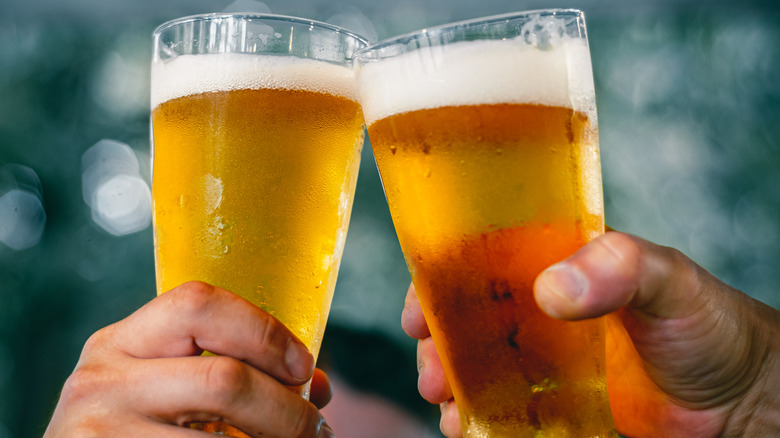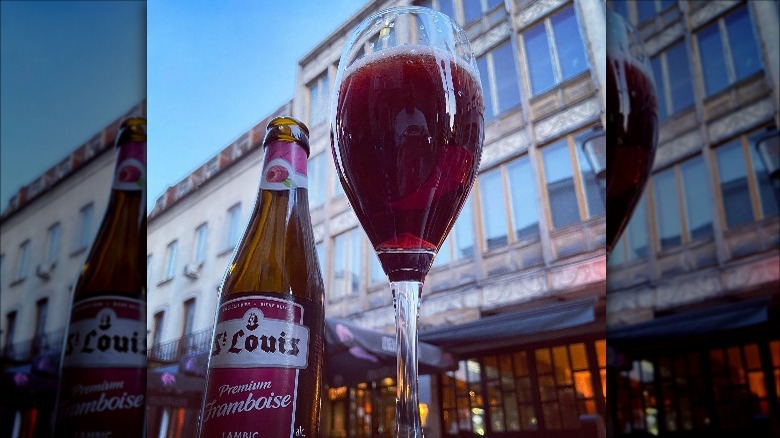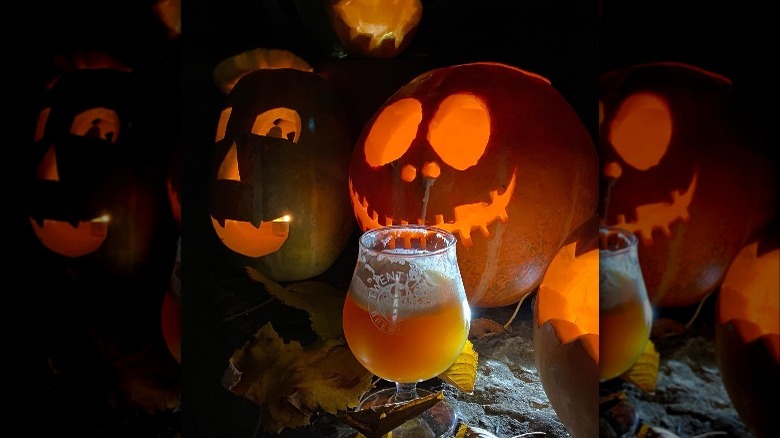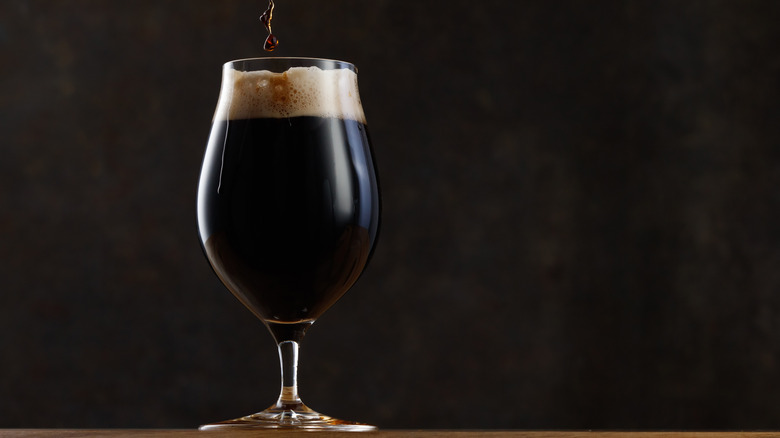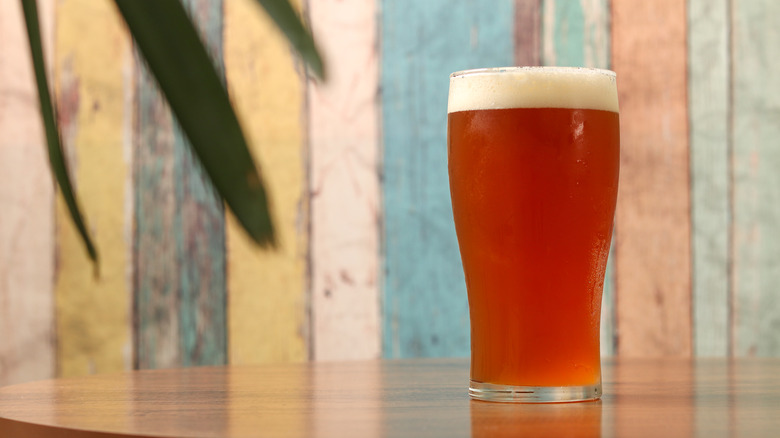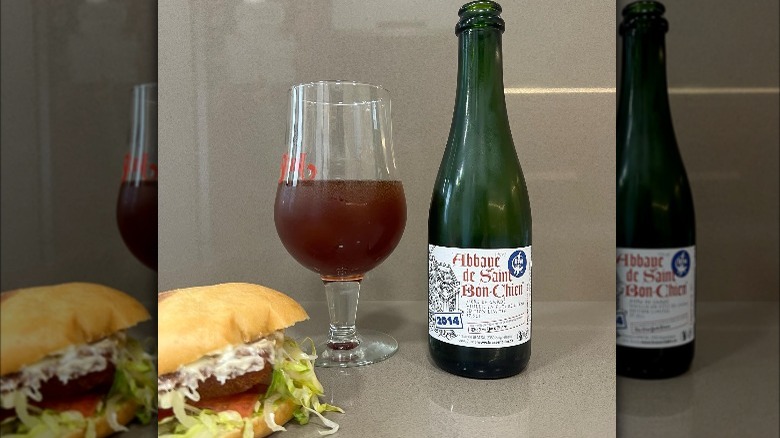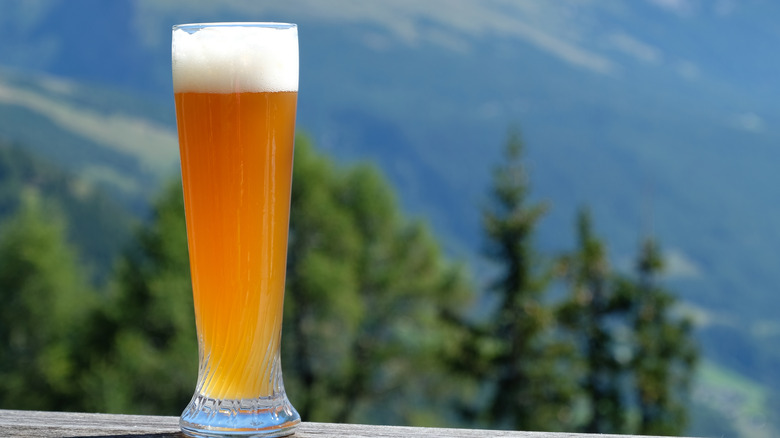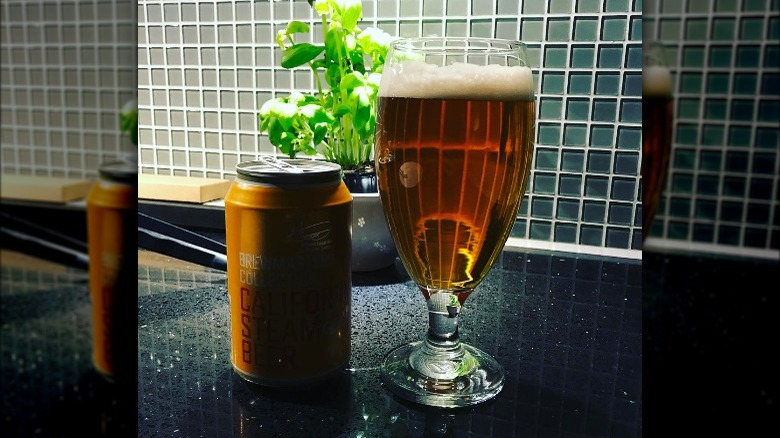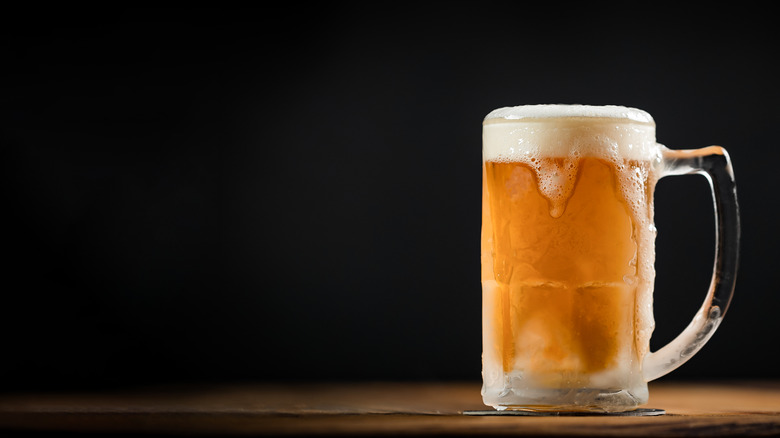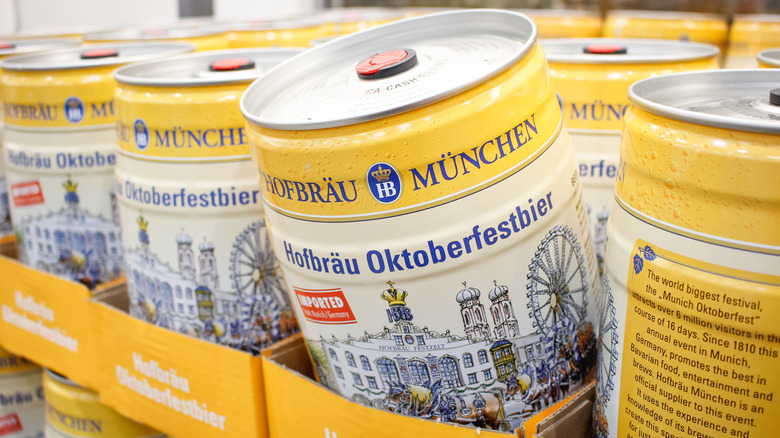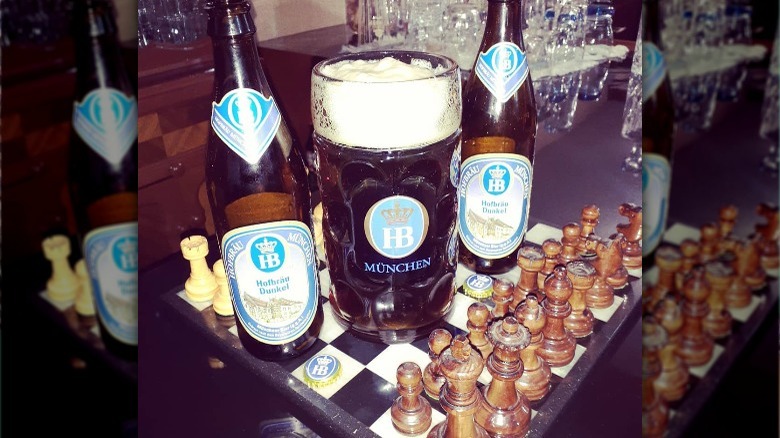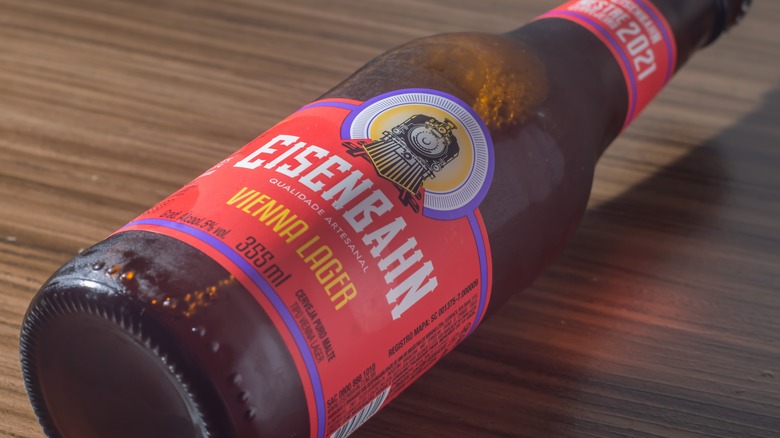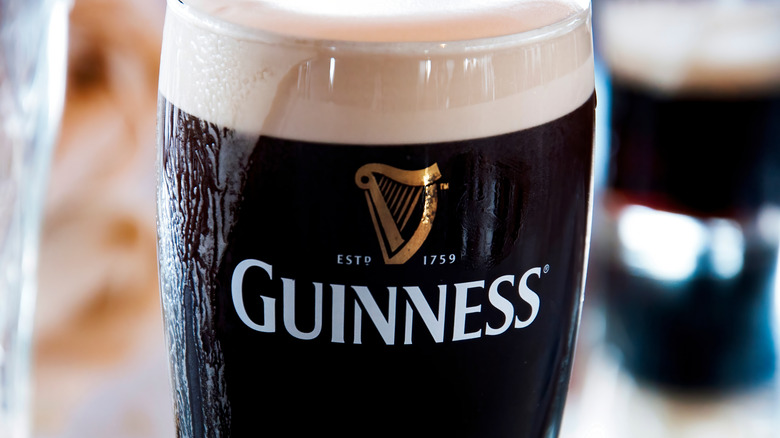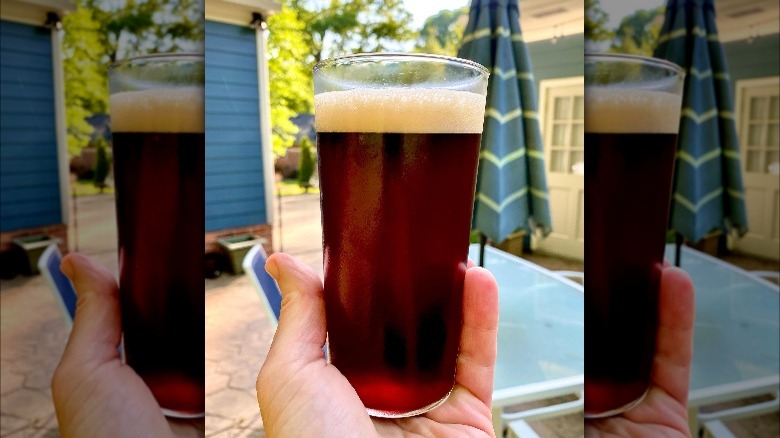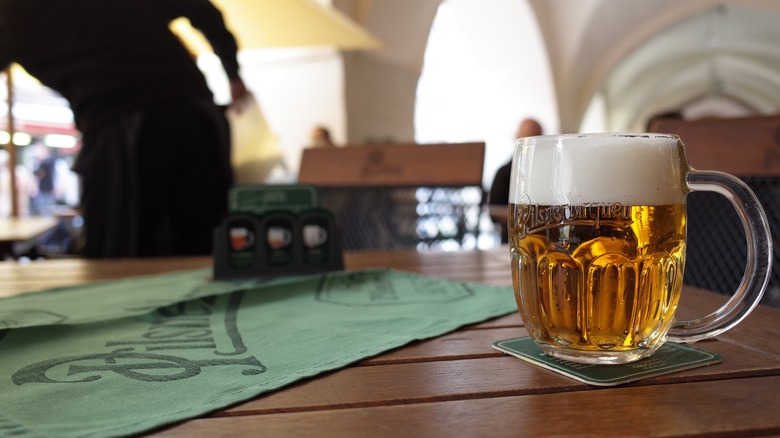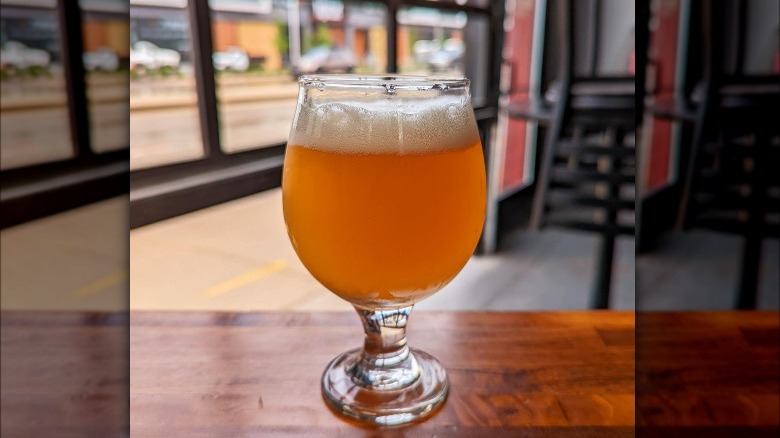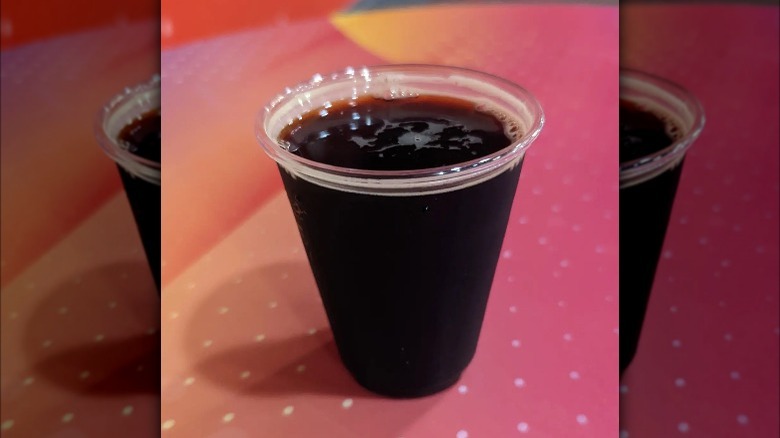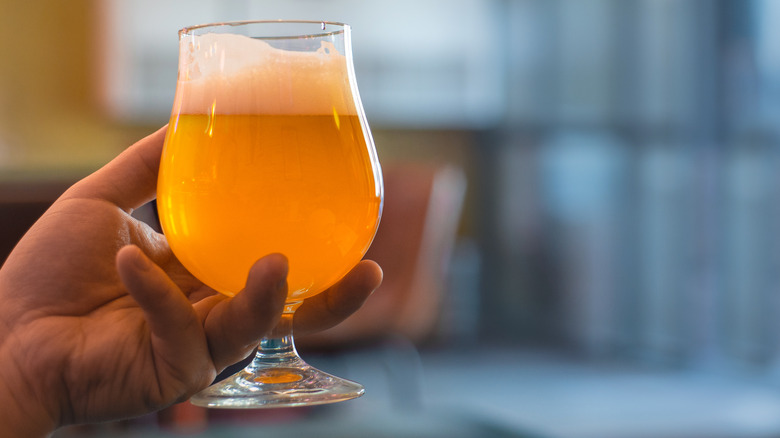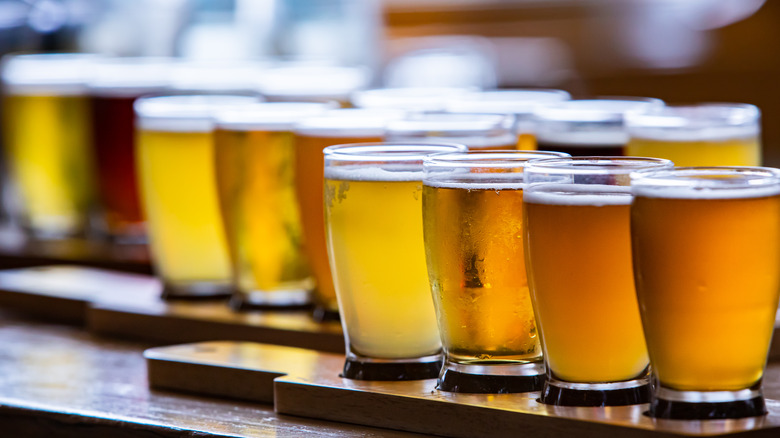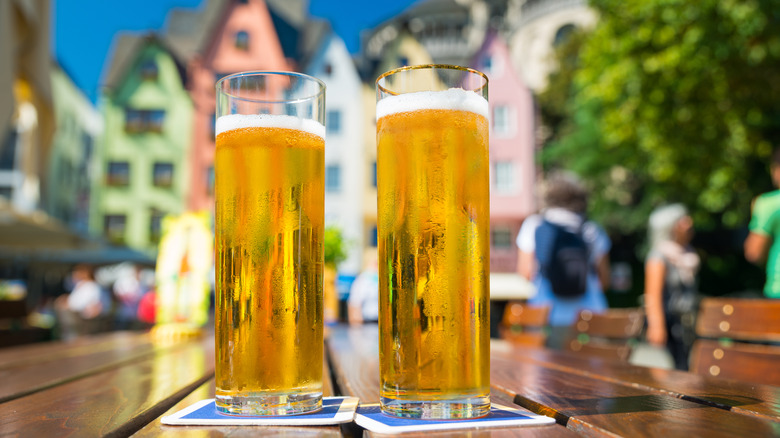20 Types Of Beer And What Makes Them Different
We may receive a commission on purchases made from links.
Beer may seem like the select stuff of hipsters and sports fanatics alike, but the drink has a seriously global history that spans centuries and transcends stereotypes. Studies suggest that beer has been brewed since ancient times and may correspond perfectly with the rise of humanity. Some reportedly believe that brewing beer allowed ancient people to harness the relaxing powers of fermented fruit. But there were pragmatic aspects to the enjoyment as well. As one archaeologist theorizes to Business Insider, beer could not only satiate, but was also much safer than drinking water for a long time. As The Beer Institute further argues, fermented grain could have provided much-needed protein that unfermented grain simply couldn't have.
Perhaps alluding further to beer's importance to culture is the fact that it can be found holding a spot in some of the most legendary ancient empires: from the empires of Mexico, to the Fertile Crescent, to China, Egypt, and Rome. Much later, in medieval Europe, beer became the work of monasteries, where it was perfected over the next several centuries according to Craft Beer and Brewing. During the Age of Exploration, beer was brought along with pilgrims and made it to North America by the 17th century.
Simply put, beer's history and influence are deeply rooted in cultures around the world. No wonder there is so much variety to one drink. Read on to learn more about 20 different beers and what makes them each uniquely drinkable.
Lambic (fruit) beer
Lambic beer may be a fairly recent addition to the U.S. beer roster, but it has a long tradition overseas in Belgium (via Hop Culture). Despite the growing popularity, there's still a lot of murkiness that surrounds this brew. Some purists would argue that the term "lambic" should refer only to Belgium-based brews, sort of like how Champagne famously only refers to sparkling wine from the Champagne region of France.
Others claim the process is much more fundamental to the brew than its birthplace. And boy is the process of making a lambic beer extremely specific. Lambic beers, as described by Hop Culture, are made from a mix of malts, like barley and unfermented wheat. They are mashed together with aged hops and boiled for hours on end. The article credits the ensuing spontaneous fermentation for the lambic beer's unique taste, because it allows for the brew to pick up the unique flavor profiles of the bacteria used to make it. This creates a rich yet refreshing mix of flavors and a bold beer.
One of the oldest forms of lambic beer is the framboise, which adds fresh raspberries to the brew during its aging process. The result is nothing short of fresh and funky. As Craft Beer and Brewing sees it, the raspberry makes for a rich aroma, and its tart flavor compliments the complex and bright lambic beer perfectly.
Seasonal brews
A beer for every season, and a season for every beer. As Deep Plate postulates, there are simply some ingredients that pair best with each season. The site notes that summer beers, like shandies, are light with hints of both citrus and flowers. Conversely, winter beers are heavy and dark, while often seasoned with festive spices like nutmeg, clove, and allspice. Spring beers are bright and utilize seasonal hops, while autumnal beers are crisp and warm and utilize the wide array of fall spices fully. As Deep Plate cheekily notes, autumnal beers tend to be the most popular seasonal beers. After all, fall is when the legendary beer festival Oktoberfest is held.
It's impossible in this day and age to mention seasonal drinks and not acknowledge the current reign of the PSL, aka Pumpkin Spice Latte, as queen of the season. It's no surprise that this magic has been incorporated on the other side of the drink spectrum. The designated Craft Beer website even posits that there is no better pairing than pumpkins with beer. As the site notes, some pumpkin beers use actual pumpkins while some go for just spice instead, as the gourd itself isn't that flavorful. Though some might crinkle their nose at the idea of a pumpkin spice beer, as the craft brew site asserts, the brews can range from malty and spicy to extremely light and crisp. There's something for everyone at this pumpkin patch.
Porter and stout
Porter and Stout, stout and porter. The names are different, but the brews are basically the same. They are, in short, brew bros. Or maybe more accurately, brew fraternal twins. So minute are their differences, in fact, that Uproxx says in broad categories, they're one to one — both are dark beers that share the same flavor and scent profile. Both can be traced back to England. But porters were made first to appease a broad taste by combining dark ale with malted barley and hops to make a generally more palatable dark beer. Stouts were allegedly born by making increasingly strong porters.
But, as the website notes, the differences nowadays aren't as simple as stout being a strong porter. In fact, the differentiation is related to a completely different aspect of the beer. Now, the major difference between porters and stouts is that the porters have malted roasted barley, while stouts have roasted barley and roasted malts. It's a tongue twister of a difference that primarily affects the brewing and not the enjoying. Serving wise, as observed by Uproxx, nowadays stouts are generally served a bit smoother"than porters with the help of a nitro tap. So, depending on small individual preferences, kick back and enjoy the smooth chocolate-like goodness of a porter or a stout, or maybe both. For those looking for a little indulgence in the starkness of winter, the Meantime Chocolate Porter offers a little time out for enjoyment.
India Pale Ale (IPA)
The Guardian defines IPAs, or India Pale Ales, as strong beers (around 5% to 7% alcohol content) that took the 2010s craft beer scene by storm. But the IPA is really a tale of globalism. English colonists set up in India could not brew their own beer due to non-existent refrigeration and the climate. To fill the gap, a beer needed to be concocted that could survive the 6-month trip, and that beer was, of course, the IPA. As The Guardian surreptitiously observes, it was even found that the IPA took really well to the voyage, and aged like a fine wine — well really, like a fine beer. The pale ale became paler with time and was adjusted for the taste and palate of India. The Beer Connoisseur even argues that it wasn't so much the beer shortage in India, but really the refreshing paleness of the recipe that made this beer so popular with the subcontinent that it became synonymous with it.
As refrigeration and cooling practices began to be perfected, the pale ale faded into obscurity for until it was revived and imbibed in the American brewing scene of the '70s (via The Guardian). As Americans began to tinker with an old recipe, modern IPAs became hoppier and more heavy-footed in terms of alcohol content. Now, the IPA has once again rocked back into center stage as an artisanal beer and globally adored phenomenon.
Bière de Garde
While England or Central Europe may first come to mind when thinking of beer, Bière De Garde proves that France shouldn't be overlooked. According to Craft Beer and Brewing, this style of beer is a part of the farmhouse ales family, along with the Belgian saison beers. As detailed by the site, both were traditionally, as the name implies, made in farmhouses during the end of beer brewing season and meant to be stored during the chillier months of the year. Historically, farmhouse beer is much weaker in comparison to other styles. They linger around 3% to 4% ABV, but this has doubled in modern adaptations.
There's a lot of variability to Bière De Garde, according to Craft Beer and Brewing. Often times, the location can say a lot more about the beer than the label. In general, the site describes the beer as amber in color and malty in taste. The modern Bière De Garde recipe was developed in the '40s, but grew to become a beloved staple among French students in the '70s. Since the modern adaptation, the beer is often served corked, like Champagne. Though unlike wine, the notes of "cork" in this beer can add to the entire experience. This isn't an intense beer, but for those patient enough to enjoy, All About Beer assures that this provincial beer is just as nourishing as it is refreshing.
Hefeweizen
Hefeweizen is a German wheat beer that, compared to other beers on the list, is much simpler in structure. It's really all in the name, as noted by Hop Culture, which translates to yeast and wheat. Lo and behold, those are the two most important ingredients in this brew, and together they make for a golden pour topped with an especially thick head of foam. It's not the most complex recipe, but there certainly is something to be said for simplicity.
Originating from Bavaria, hefeweizen's unfiltered wheat and yeast not only make the beer cloudy, but also add an unmistakable bitterness to the entire affair (via The Beer Cartel). Not to worry, the site assures that this cloudy and bitter beer is still surprisingly refreshing.
There are actually two schools of thought when it comes to hefeweizen, or rather two countries of thought: the OG German hefeweizen and the American hefeweizen, aka the Widmer Hefe of Portland. The Widmer Hefe was groundbreaking in that it left beer unfiltered in a time when American beers were typically clear (via Hop Culture). But as Beer Cartel points out, there are a few other points that differentiate the German from the American: the American hefeweizen is maltier due to the type of yeast it uses, while the German version is less hoppy, but more wheaty than its American descendant.
Steam (California common beer)
California may be known for its wine, but not as many people know that the West Coast also lays claim to a beer. Legend goes that the California common first came to fruition during the gold rush that drove hoards of workers to the state (via Craft Beer Club). Presumably, with an influx of famished and drink-ready workers, there was a push to have a fresh beer ready at the tap. San Francisco, specifically the Anchor Steam Brewing Company, is credited with putting steam to the steam beer (via Craft Beer). In fact, the brewery to this day is the only brewery that can legally use the name steam beer.
The California common, like a stout, can have heavy flavors of caramel and toasted malt. But, Craft Beer makes sure to also note that the hops usually sourced for the California Common add a unique "woody" and "mint" flavor to the steam beer. This beer is nonetheless a warm honey color, and contains max 5.7% ABV. When hunkering down with a steam beer and an empty stomach, Craft Beer recommends heartier pairings like pork loin, or even bread pudding, for some eating that's sure to satiate miners and bar patrons alike.
Munich Helles
The Münchner Hell is a site-specific brand of beer, as indicated by the name. In fact, Munich and the Munich Helles are so interwoven that the beer is considered by some to be the "true symbol of Munich." What today is a classic was once an innovation, and once upon a time in the late 19th century, the helles beer took hold Central Europe (via Kegerator). In the otherwise dark landscape of Bavarian beer, the golden Helles beer shed a long-lasting light. Existing on the coattails of innovation in English brewing and trends towards light beers at the time, the Munich Helles was developed to be a crisp and golden lager.
A proper Munich Helles beer must be golden and bright, mild yet "elegantly" malty, and slightly hoppy (via Paulaner). The beer is traditionally enjoyed lackadaisically under the shade of a chestnut tree. Luckily for those with no access to such trees, there are many ways to pair the Bavarian superstar. The Kegerator asserts that the Munich Helles is so light that it's best left untethered. The site suggests lighter dishes like bowls of berries, brie, and flounder to keep the golden beer golden. That being said, the site also mentions that the beer's maltiness goes well with bread — perhaps pair it with a Reuben sandwich?
Oktoberfestbier
As the name implies, Oktoberfestbier is a beer for Oktoberfest. After all, why would the world's largest beer festival not have its own beer? The Oktoberfestbier is actually so intrinsic to the festival, that it has protected status (via Taste Atlas). Only six breweries in Munich can even brew the beer legally.
Simplified to Festbier, or festival beer, the current iteration has only existed since the '90s as clarified by Saveur Bière. Festival beer is similar to the Munich Helles, which means it has virtually no notes of hops and herbs, but is heavy on the malt and according to Taste Atlas, as smooth as can be. Of course, this is all paired off with a foamy head that puts the icing on the metaphorical cake. Naturally, the giant liters that the Festbier are served in are good on their own, but the Oktoberfest beer does play well with others. Notably, or typically, this foamy beer does well by pretzels, Weisswurst, or any other delights that one might come by at the fairgrounds. At home, or at the dessert table, Oktoberfestbier can even be tamed with dishes like walnut pie, according to Saveur Bière, which makes for an especially autumnal mix.
Munich Dunkel
On the other side of the color spectrum from the "light" Munich Helles, is the Munich Dunkel or "dark." Really, the dark beer preceded the Munich Helles, and at one point was much more common (via Alcohol Professor). Though they may look intimidating, especially when served up in a liter mass like pictured above, this is a gentler beer with tons of malt to make for a mellower brew. Munich Dunkels can be found in a wide range of shades, though a good rule of thumb is that Munich dark, should to some extent, be dark.
Besides the color, what defines the Munich Dunkel is its flavor profile. The Alcohol Professor notes that Munich Dunkels are unique because the water surrounding the city is filled with calcium carbonate, which makes the beer both "sweeter" and "fuller" than other brews. Taste Atlas describes as both "caramel-like" and "toasty." Needless to say, this is a comforting drink, although Taste Atlas makes sure to say this isn't a heavy beer. The Alcohol Professor argues that this beer doesn't necessarily need to be reserved for a cold day. Although, that being said, it does happen to work wonderfully with all the comfort foods that make those chilly nights all the more magical.
Vienna lager
Vienna-style lager came about near the end of the 19th century, when an Austrian brewer combined British malt-drying sensibilities with lager yeasts, and thus the copper beer was born. The Vienna lager is a malty and mellow brew that straddles an exciting line between "creamy" and "crisp", "smooth" and "toasty", as described by Taste Atlas. It certainly is a precarious place to be. But, as noted by Hop Culture, in order to be an authentic Vienna lager, the brew needs to have the characteristic color, clarity, and slightly sweet malty bitterness flavor that defines the beer.
It's a tragedy that, as reported by The Taste Atlas, Vienna lagers have not been common in their birthplace since World War I. Hop Culture observes that, in general, Vienna Lagers are hard to find on tap. The beer-oriented website links this problem to the fact that in comparison to other beers, the Vienna lager isn't made easily: it needs time to ferment, and it needs to be made perfectly to balance correctly. Even when all these things do happen, Vienna lager is often, for supposed marketing purposes, labeled as an amber ale or even as an Oktoberfestbier. If on the hunt for this rare gem, a good place to start is with the Great Lakes Brewery's very own Vienna Lager. For a bit of cultural fusion, the Brewing Company suggests pairing the dynamic drink with chicken tostadas.
Irish dry stout
While the term Irish dry stout might not be the most familiar, the name Guinness is sure to ring a bell or two. Really, Guinness encapsulates the major brushstrokes of the Irish dry stout with aplomb: full-bodied, richly colored, and topped with a foamy head. The foam head is really thanks to the nitrogen tap used to give the drink its iconic topping (via Craft Beer).
Still though, Hop Culture sees the beer's roasted barley as Irish dry stout's most defining characteristic. After all, both sources link the roasted barley with the drink's incredibly dry texture and unforgettable color. Although, Hop Culture is also quick to note that Guinness isn't really "black," so much as an extremely dark ruby. The drink's hops also lend to the bitter flavor that characterizes the Irish dry stout. A good Irish stout should also have a certain earthiness to it that's not as distinct in other types of stouts. Craft Beer says Irish dry stouts, despite their intense flavor, work with a full cast of characters: they can be enjoyed with oysters, Irish cheddar, and chocolate desserts alike.
Irish red ale
The Irish red ale, for all intents and purposes, is only really known as an Irish red ale outside of Ireland (via Brewer World). The ale found secure footing in the States since its first major commercial debut with Coors some 40 years ago. Hilariously enough, the Coors' Irish red ale isn't even ale, but actually a lager. The difference between ales and lagers is mainly just in fermentation: ales are fermented at warm temperatures with top-fermenting yeast, while lagers are fermented at low temperatures with bottom-fermenting yeast (via Tapville Social).
There are two things that really set Irish red ale apart. The first, of course, being its rich red color, which is always topped with an off-white head. The Irish red ale is quite straightforward, and there won't be much complexity to the beer's taste beyond its signature malt. But, it's this malt that achieves the ale's characteristic caramel-toffee-like flavor, according to Craft Beer and Brewing. A good Irish red ale should have, as per Brewer World, a toasty finish to really top off the entire experience. Irish Red Ales are crisp and well-rounded enough to start the summer off or even be served up as a nod to a love potion on Valentine's Day.
Pilsner
When it comes to beers, pilsner is one of the most enjoyed brews to date, according to The Manual. Way back when they were invented in the mid-19th century, pilsners literally changed the game. At a time when most beers were brewed through a warm top-fermenting process, pilsners flipped the script and utilized a slower bottom-fermenting process. The reason for the switch up was that at the time, warm fermenting processes often resulted in sour, at times irregular and undrinkable beer. While the cold bottom-fermenting process will always be a labor of love and time, the result was a much more consistent beer (via the Czech Center). The rest was, as the saying goes, history.
Though the brewing methods have industrialized and modernized over the centuries, the pilsner's core characteristics remain unchanged. VinePair describes a classic Czech pilsner as striking a balance between malts, spice, and floral notes. But the pilsner centers itself on bitterness, which is "more bracing than aggressive," says VinePair This seems to be the formula that works. As the Czech Center notes, this style of beer still remains the best-selling beer in the Czech Republic. As time changes and the pilsner finds itself at times far away from central Europe, what does remain is the pilsner's nice, clean finish. Some things just can't be improved upon.
Wild beer
According to Allagash Brewing Company, wild beers are really just sour beers. Though of course, the name sounds a little bit more free. It seems fitting too, as wild beers, so often concocted by craft brew companies, have taken old styles of beer and completely reinvented them once again. But, there's further reason to stick with wild. As the brewer notes, while sour might be a trait of a lot of wild beers have, there's a much larger flavor spectrum to the drink. The name "wild" in wild beer also refers to the wild yeast, Brettanomyces, used to lend this beer particularly unusual, but sought after, flavors like "barnyard" and "mousy," but also fruity.
So, as you can see, calling it sour just simply doesn't do this beer justice. Although, souring the beer with additional bacteria is very important to the process of making a wild beer. As Chatelaine so aptly describes, the process of making sour beers is similar to making sourdough – it's all about getting the right bacteria and flora to make for a pleasantly funky taste. When pouring up and hunkering down into a glass of wild beer, you're really venturing out to the frontiers of current brewing — an exciting, and of course, wild place to be.
Coffee beer
There's something about coffee and beer that just works. It's been noted that beers, like stouts, can have hints of coffee. So what happens when going all in? As Fresh Coffee House observes, in a coffee and beer-loving country like the U.S., there's been a push for brewmasters to bring the two opposing but equal forces into perfect harmony.
As the site observes, long have dry coffee beans and cold brew been incorporated into the brewing process. Traditionally, dark malty beers like stout react really well to the acidic, aromatic, and flavorful elements of coffee. But, as the art is being perfected, it's also become a lot more playful and can vary extremely. In this versatile world of coffee and beer, Coffee Affection advises reading the label and asking before purchasing. After all, coffee beers can range from having hints of coffee to tasting predominantly like the stuff, while some actually have absolutely no coffee in them. There are lots of way to enjoy a buzz with this brew.
Gose
Gose belongs to the German family of beers that distinguishes itself by having an extremely sour taste (via Masterclass). It's because of this sourness that gose beers are often confused for or referred to as both sour and wild beer. Admittedly, the difference between the two is minute, and it can get murky given that both taste extremely similar to each other. Draft Magazine cuts through the confusion and lays it out as simply as possible: While wild beers use the sourdough-like bacteria to get their funky flavor, gose beers utilize sea salt and coriander. This mix of ingredients lends gose its flavor, along with a hint of citrus and salinity. Gose beers are also fermented more quickly than wild beers with a "kettle sour" method.
There are even further distinctions within the gose beer genre, and that lies between the traditionally crafted (Leipiziger) gose and the American-brewed gose, which tends to take an innovative craft beer approach. MasterClass describes American gose beers as "bold" and "juicy," and it's not uncommon for extra fruit flavors like blood orange, passion fruit, or even pineapple to be integrated into the brew. Perfect for the summer, Draft Magazine suggests pairing gose beers, regardless of nationality, with goat cheese or seafood, or bringing it to share at the next barbecue.
Session ale
Session ale is a bit confusing, as it's not really a type of beer per se, but more so a category. Session beer is defined as any beer that's especially refreshing while lingering below 5% ABV (via Allagash Brewing Company). But, as the brewing company admits, these stipulations are incredibly broad. There are a lot of different beers that can be seen as a session ale, from gose to Guinness. After all, how should refreshing be defined?
The real challenge to the category, as illustrated by Craft Beer, is maintaining the beer's character and style, while also lowering the alcohol content. As the site simply states, drinkability is the key to session ales. So with that in mind, session ales can be found just about in every form and paired with just about anything, depending on the brew. What will stay the same is that session ales will not have an alcohol content exceeding 5% ABV and will never be very bitter. For those who are looking to quench their thirst without getting too tipsy, know to ask the local bartender or liquor store about their selection of session ales to make the most informed decision.
Kölsch
Outside of the Bavaria universe of light and dark beers is the subtle yet potent Kölsch, which is much treasured and cherished by its home city of Cologne (via Taste Atlas). The Kölsch is actually the lightest of the light German ales, and is sure to hit the spot. Unlike Bavarian beers, Kölsch beers are not served by the gargantuan mass, but rather a tall Kölsch glass. Be careful when ordering at a typical Cologne bar, though, as the traditional way to indicate that you're done is by putting a coaster on top of your glass. Otherwise, you will keep being served.
But you don't need to go to Germany to do as the Germans do. As Tasting Table boldly declares, Kölsch should be your next go-to-beer to go to for the summer. According to the article, Kölsch is the perfect summer companion for a chill night — it's low-alcohol and refreshing. Maybe this is why American breweries are starting to turn their eyes towards one of Germany's best kept secrets. While maybe not the fusion cuisine that first comes to mind, Magnolia's makes a Kalifornia Kölsch that pairs the easygoing nature of the golden beer with the breeziness of the golden state.
